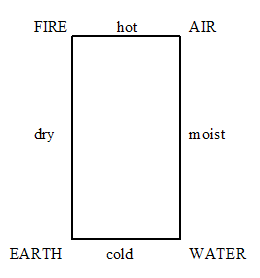Pre-Atomic
Theory
The
understanding of the physical world changed as the development of the
atomic theory progressed. The view of the world before the atomic
theory is important to consider when trying to understand the kind of
knowledge that people such as Democritus and Epicurus had when
developing their theories that later influenced the further development
of the atomic theory.
Alchemy
Alchemy is normally thought of as the transition of
metals into gold. In reality alchemist are said by William H.
Brock were “often concerned with a spiritual quest by humankind to make
sense of the universe.” The transition of metals was only a small
portion of what alchemy entailed.
There were three main terms used when describing the work of early
alchemists; macrobiotics, aurifiction, aurifaction. Macrobiotics
used the understanding of botanical, mineral and zoological areas and
then created medicines or as the people of the alchemical times called
them, elixirs. Aurifiction was the imitation of gold or other
precious metals. Aurifaction was the process of actually creating
gold from another metal.
Geography greatly influenced the practices of
alchemists. All over the world people were exploring the natural world
and its chemical and physical properties.
Rituals similar to those involved in child birth were often found in
Siberia, Indonesia and African alchemical procedures. Brock
comments that, “like embryos, metals grew in the womb of mother
nature.” There were myths associated in the creation of metals
and why they were present in the world.
In the Indian, Chinese and Arabic cultures they believed in the “elixir
of life” and the alchemy taking place in these regions were focused on
the body and the combination of what the body needs and what the body
releases were of great importance. The Arabic culture is said to
be responsible to spreading these ideas to 14th century Europe.
When focusing on the development of scientific understanding it is
necessary to take a closer look at the beliefs of the natural world of
the various geographic areas.
China
 As
stated earlier,
China was more focused on producing elixirs and drugs than the
transition of metals. Brock states that they waned to, “bring the
body closer to a state of perfection and harmony with the universe.”
Undergoing this process would eventually lead to immortality.
As
stated earlier,
China was more focused on producing elixirs and drugs than the
transition of metals. Brock states that they waned to, “bring the
body closer to a state of perfection and harmony with the universe.”
Undergoing this process would eventually lead to immortality.
Naitan was the term associated with the physiological alchemy. It was
based on the belief that immorality and longevity were made possible by
a substance that is made by the body, an “inner elixir”.
All substances were either Yin or Yang rich. Yin rich were
associated with male, light, hot and positive. Yang rich were
female, cool, dark and negative. The appropriate combination of
these components were said to heal any sickness and lead to
divinity. One specific combiniation lead to the discovery
of gun powder. This was done by mixing Yin-rich saltpeter and
Yang-rich sulfur.
China was not completely free of the transformation of metals into gold
theories of more western cultures. They believed that the
Yang-rich red-blooded cinnabar would transform itself into gold.
This dates all the way back to 133 B.C.
Greece
As far back as 3000 BC the Greeks were extracting medicines and
perfumes from plants, animals and minerals. The Greek society that
prided itself in being intellectual and on the brink of discoveries
were learning about the natural world thousands of years ago.
The Greeks associated metals and alloys with the planets, and days of
the week.


Plato and Aristotle both taught about the four
elements. Aristotle distinguished between the differences of the
physics of the heavens and the physics of the natural world. The
heavens were said to possess a natural circular motion that was both
perfect and unchanging. The Earth was believed to be full of
change, and decay. The atomic theory that was developed by
Democritus was rejected by Aristotle because he was concerned it did
not explain the vast variety of materials.
This brings to the development of the atomic theory taught by
Democritus. His theory stated that the apparent differences between
various substances come from the differences in both sizes and shapes
of small indivisible homogenous particles.
Back to table of contents.


 As
stated earlier,
China was more focused on producing elixirs and drugs than the
transition of metals. Brock states that they waned to, “bring the
body closer to a state of perfection and harmony with the universe.”
Undergoing this process would eventually lead to immortality.
As
stated earlier,
China was more focused on producing elixirs and drugs than the
transition of metals. Brock states that they waned to, “bring the
body closer to a state of perfection and harmony with the universe.”
Undergoing this process would eventually lead to immortality.
